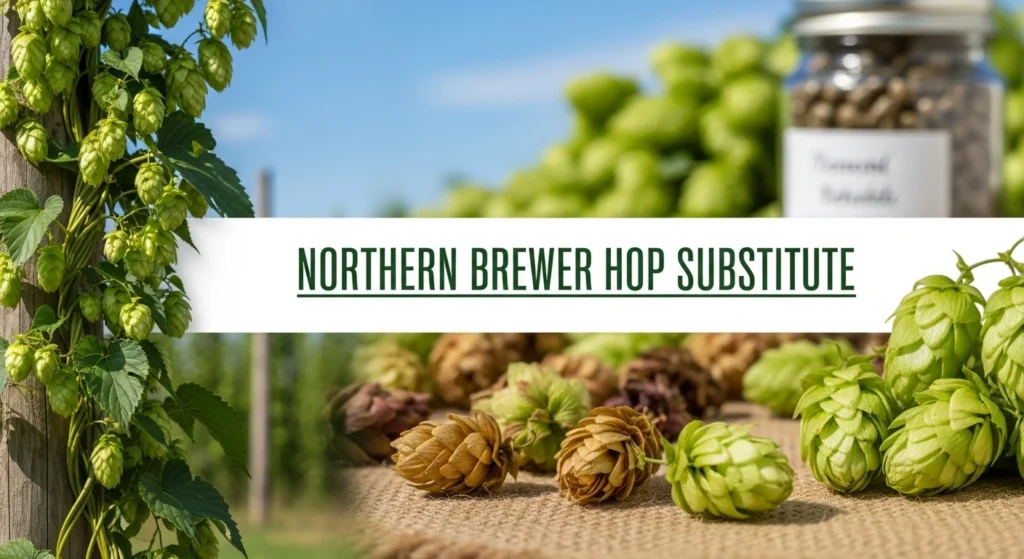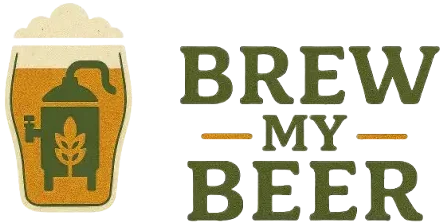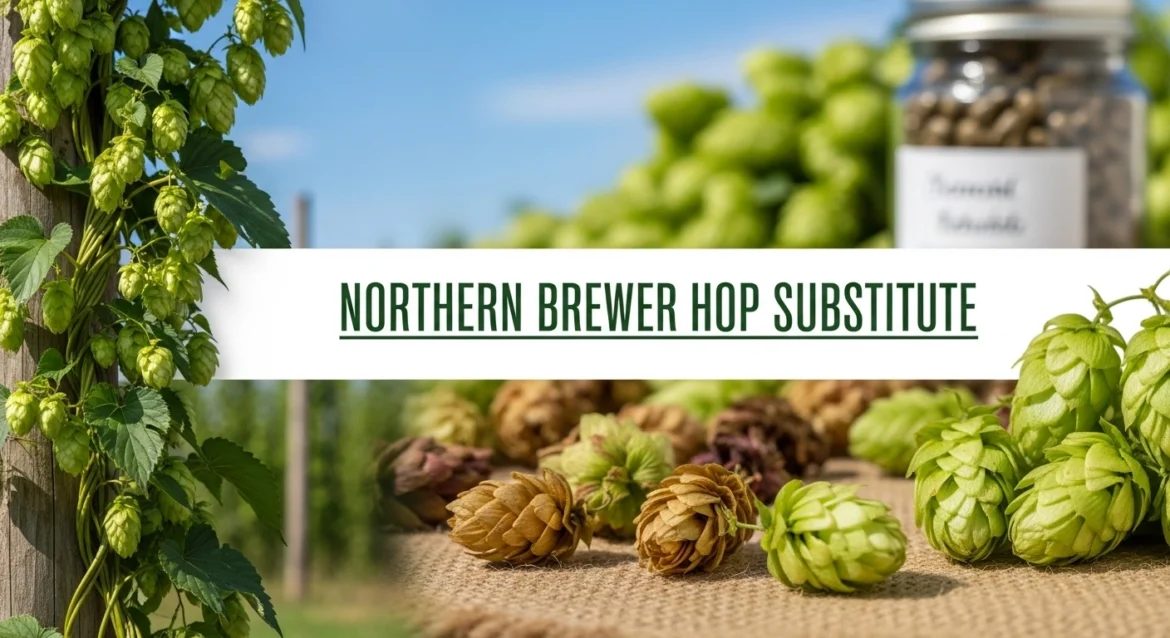Can’t find Northern Brewer hops? Discover the best Northern Brewer hop substitute options including Chinook, Perle, and Fuggle. Complete brewing guide with substitution ratios and flavor profiles for California Common, porters, and lagers.
Every homebrewer has faced this frustrating scenario: you’re ready to brew your perfect California Common or English Porter, the recipe calls for Northern Brewer hops, and your local homebrew shop is completely sold out. Before you panic or postpone your brew day, understanding which Northern Brewer hop substitute works best can save your recipe and might even lead to exciting new flavor discoveries.

Northern Brewer hops have earned their legendary status in the brewing world since their development in 1934 at England’s Wye College. Originally bred by crossing Canterbury Golding with a male seedling of Brewer’s Gold, this versatile hop variety has become synonymous with California Common beers and remains a staple in craft brewing worldwide. But what makes it so special, and more importantly, what can you use when you can’t find it?
Understanding Northern Brewer Hop Characteristics
Before diving into substitutes, let’s explore what makes Northern Brewer hops unique. This dual-purpose hop delivers a complex flavor profile that’s surprisingly difficult to replicate with a single alternative variety.
The Flavor Profile
Northern Brewer hops display medium intensity with distinctive pine and minty notes, complemented by woody and evergreen characteristics. Unlike the citrusy American hops that dominate modern IPAs, Northern Brewer brings an earthy, herbal quality that feels simultaneously traditional and distinctive.
When you crack open a bag of fresh Northern Brewer pellets, you’ll immediately notice the aromatics—think Christmas tree meets fresh mint with underlying notes of black pepper. This unique combination makes it the signature hop for California Common beers, which showcase the woody and minty Northern Brewer varietal hop character.
Chemical Composition
Understanding the technical specifications helps identify suitable Northern Brewer hop substitute options:
Alpha Acids: 6.0-10.0%
Beta Acids: 3.0-5.0%
Cohumulone: 27-32% of alpha acids
Total Oil: 1.0-1.6 ml/100g
Key Oil Components:
- Myrcene: 25-45% (contributes herbal, earthy notes)
- Humulene: 35-50% (adds woody, spicy character)
- Caryophyllene: 10-20% (provides peppery spice)
The moderate alpha acid content makes Northern Brewer ideal for bittering, while its rich oil profile delivers substantial flavor and aroma contributions. This dual-purpose nature means you need to consider both bittering and aromatic qualities when selecting alternatives.
Regional Variations
Interestingly, Northern Brewer hops grown in different regions develop distinct characteristics. US Northern Brewer contains slightly higher alpha acids and high myrcene oil content than the German variety, resulting in a herbal, wood, and peppery aroma. German Northern Brewer, predominantly from the Hallertau region, tends to be more refined with cleaner pine and mint notes.
Best Northern Brewer Hop Substitute Options
When your local shop is out of Northern Brewer, several hop varieties can step in as capable understudies. However, remember that no substitute perfectly replicates Northern Brewer’s unique character—think of these as creative alternatives that bring their own personality to your brew.
1. Chinook Hops
Alpha Acids: 10-14%
Best Use: Bittering and late additions
Similarity Rating: ★★★★☆
Chinook delivers mild to medium-heavy characteristics that are spicy, piney, and grapefruity, making it one of the closest Northern Brewer hop substitute options available. While it shares the pine notes with Northern Brewer, Chinook adds grapefruit undertones that give a slightly more assertive, American-style hop character.
Substitution Tips:
- Use 75-80% of the Northern Brewer amount due to higher alpha acids
- Works exceptionally well in porters and stouts
- Consider blending with Perle for better minty character
2. Perle Hops
Alpha Acids: 6-9.5%
Best Use: Dual-purpose applications
Similarity Rating: ★★★★☆
German Perle hops provide a moderately spicy, minty character that closely mirrors one of Northern Brewer’s key characteristics. Known for its aromatic and bittering properties, Perle offers pleasant and slightly spicy notes that work beautifully in traditional European-style beers.
Substitution Tips:
- Use 1:1 ratio for similar alpha acid levels
- Excellent for German lagers and English ales
- Maintains clean, traditional hop profile
3. Fuggle Hops
Alpha Acids: 4-5.5%
Best Use: Aroma and flavor additions
Similarity Rating: ★★★☆☆
For brewers prioritizing the earthy, woody character over bittering power, Fuggle hops present an interesting Northern Brewer hop substitute. While lower in alpha acids, Fuggles contribute a pleasant, earthy character with herbal undertones.
Substitution Tips:
- Increase quantity by 50-70% to achieve similar bitterness
- Ideal for English-style ales and porters
- Consider pairing with higher-alpha hops for bittering
4. Hallertau Mittelfrüh
Alpha Acids: 3-5.5%
Best Use: Aroma and flavor
Similarity Rating: ★★★☆☆
As a noble hop variety, Hallertau brings refinement and traditional European character. It offers mild and pleasant, slightly spicy notes that complement malt-forward beer styles beautifully.
Substitution Tips:
- Best for German lagers and Belgian ales
- Pair with higher-alpha hops like Magnum for bittering
- Provides cleaner profile than Northern Brewer
5. Cluster Hops
Alpha Acids: 5.5-8.5%
Best Use: Bittering with some aroma
Similarity Rating: ★★★☆☆
Historically, California-grown Cluster hops would most likely have been used in historic steam beers, making them an authentic alternative for traditional American styles.
Substitution Tips:
- Adjust amounts based on alpha acid content
- Works well in California Commons and American amber ales
- Provides more rustic, less refined character
Style-Specific Substitution Strategies
Different beer styles emphasize different aspects of Northern Brewer’s character, so your substitute choice should align with your brewing goals.
For California Common (Steam Beer)
Making a beer similar to Anchor Steam requires Northern Brewer hops, but when that’s impossible, consider these approaches:
Primary Alternative: Chinook + Perle blend (60% Chinook for bittering, 40% Perle for flavor/aroma)
Secondary Option: Cluster hops for historical authenticity
Experimental Route: Try Spalt hops for interesting spicy and somewhat rustic character
The goal with California Common is achieving that signature woody, minty character that defines the style. Northern Brewer hops have touches of mint, thyme, and earthiness that are difficult to find in other hops, so expect some deviation from the classic profile.
For English Ales and Porters
Best Substitutes: Fuggle or UK Challenger
English-style beers benefit from the traditional, earthy hop character that both Northern Brewer and these alternatives provide. The slightly lower alpha acids work perfectly for balanced, malt-forward profiles.
For German Lagers
Best Substitutes: German Perle or Hallertau
German lagers call for refinement and subtlety. German-grown Perle delivers similar pine characteristics while maintaining the clean, traditional profile that German brewing demands.
Creating Hop Blends for Better Matches
Sometimes the best Northern Brewer hop substitute isn’t a single variety but a carefully crafted blend. Professional brewers frequently combine hops to achieve specific flavor targets, and homebrewers can employ the same technique.
The “Pseudo-Northern Brewer” Blend
For 1 oz Northern Brewer, use:
- 0.5 oz Chinook (provides pine and bittering)
- 0.3 oz Perle (adds minty, spicy notes)
- 0.2 oz Fuggle (contributes earthy complexity)
This combination targets Northern Brewer’s multifaceted profile from different angles, creating a more authentic approximation than any single substitute.
The “Clean Steam” Alternative
For California Common beers:
- 0.6 oz Cluster (historical accuracy)
- 0.4 oz Santiam (contributes herbal, spicy notes)
This blend honors the style’s heritage while maintaining accessibility.
Practical Brewing Adjustments
When substituting hops, mathematical precision matters. Simply swapping varieties pound-for-pound rarely works because alpha acid percentages vary significantly between hop varieties.
Calculate Homebrewing Units (HBU)
The formula is simple: HBU = Weight (oz) × Alpha Acid %
Example: A recipe calls for 1 oz Northern Brewer at 8% alpha acids
- Target HBU = 1 × 8 = 8 HBU
If substituting with Chinook at 12% alpha acids:
- Required weight = 8 ÷ 12 = 0.67 oz
This ensures consistent bitterness levels regardless of which Northern Brewer hop substitute you choose.
Timing Considerations
Northern Brewer works beautifully throughout the boil:
- 60-minute additions: Emphasizes clean bittering
- 20-30 minute additions: Develops woody, herbal flavors
- 5-10 minute additions: Enhances pine and mint aromatics
- Dry hopping: Amplifies mint and evergreen notes
When substituting, match your replacement hop to the same addition schedule for consistency.
Common Mistakes to Avoid
Learning from others’ errors saves both time and ingredients. Here are pitfalls to sidestep when using a Northern Brewer hop substitute:
1. Choosing Citrus-Forward Hops
Modern American hops like Citra, Mosaic, or Cascade create completely different flavor profiles. Modern American and New World-type hops (especially citrusy ones) are inappropriate for styles traditionally built around Northern Brewer.
2. Ignoring Regional Variations
Remember that US Northern Brewer has slightly higher alpha acids and higher myrcene oil content than the German variety. If your recipe specifies German Northern Brewer, choose European-grown substitutes like German Perle for better results.
3. Forgetting About Beta Acids
While alpha acids get all the attention, beta acids contribute to hop stability and aging characteristics. When possible, choose substitutes with similar beta acid profiles for long-term storage.
4. Over-Complicating Simple Recipes
For lightly-hopped beers, don’t obsess over finding the perfect substitute. Many German lager recipes call for noble hops, which are all fairly neutral, so if you usually brew these styles, you should be in good shape.
Where to Find Northern Brewer Hops and Substitutes
Supply chain issues occasionally make even common hop varieties scarce. Here’s where to look:
Online Retailers:
- Yakima Valley Hops – Excellent selection and fresh inventory
- MoreBeer – Reliable shipping and competitive pricing
- Northern Brewer – Comprehensive hop variety selection
Local Options:
- Homebrewing supply shops (call ahead to check stock)
- Craft breweries (some sell surplus hops to homebrewers)
- Homebrewing clubs (members often share supplies)
Storage Tip: When you find Northern Brewer hops in stock, buy extra and store them properly. Vacuum-sealed in a freezer, hops maintain quality for 1-2 years, ensuring you’re never caught without your preferred variety.
Embrace the Adventure
While finding yourself without Northern Brewer hops might initially seem like a brewing disaster, it’s actually an opportunity for creativity and discovery. Many legendary beer recipes were born from ingredient substitutions necessitated by availability rather than design.
The key is understanding what Northern Brewer brings to your recipe—is it the bittering power, the woody aromatics, the minty freshness, or the combination of all three? Once you identify the critical element, selecting the appropriate Northern Brewer hop substitute becomes straightforward.
For foundational brewing knowledge and recipe development techniques, explore our comprehensive guides at Brew My Beer, where we help homebrewers navigate every aspect of creating exceptional beer.
Remember that brewing is both science and art. While we can calculate International Bitterness Units and essential oil profiles with mathematical precision, the final judgment happens on your palate. Don’t be afraid to experiment, take notes, and develop your own preferences. Your “wrong” substitution might become someone else’s perfect discovery.
The most important lesson? Always have a backup plan, stay flexible, and keep brewing. Whether you’re using authentic Northern Brewer or your carefully chosen substitute, the joy of homebrewing lies in the process, the experimentation, and sharing great beer with friends who appreciate your craft.
About the Author
This article was meticulously researched and written by John Brewster, Lead Brewer & Recipe Expert at Brew My Beer. With over a decade of hands-on brewing experience, John has worked at three craft breweries and won several regional homebrew competitions. His specialty lies in creating unique flavor profiles by combining traditional brewing methods with unexpected ingredients—including creative hop substitutions when his preferred varieties aren’t available. When not tending to his five fermenters, John enjoys pairing his creations with artisanal cheeses and hosting tasting sessions for fellow brewing enthusiasts. You can reach John at [email protected]

